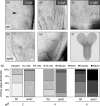Reduction of indole-3-acetic acid methyltransferase activity compensates for high-temperature male sterility in Arabidopsis
- PMID: 28574629
- PMCID: PMC5785359
- DOI: 10.1111/pbi.12768
Reduction of indole-3-acetic acid methyltransferase activity compensates for high-temperature male sterility in Arabidopsis
Abstract
High temperature is a general stress factor that causes a decrease in crop yield. It has been shown that auxin application reduces the male sterility caused by exposure to higher temperatures. However, widespread application of a hormone with vast effects on plant physiology may be discouraged in many cases. Therefore, the generation of new plant varieties that locally enhance auxin in reproductive organs may represent an alternative strategy. We have explored the possibility of increasing indole-3-acetic acid (IAA) in ovaries by reducing IAA methyltransferase1 (IAMT1) activity in Arabidopsis thaliana. The iamt1 mutant showed increased auxin signalling in funiculi, which correlated with a higher growth rate of wild-type pollen in contact with mutant ovaries and premature ovule fertilization. While the production of seeds per fruit was similar in the wild type and the mutant at 20 °C, exposure to 29 °C caused a more severe decrease in fertility in the wild type than in the mutant. Loss of IAMT1 activity was also associated with the production of more nodes after flowering and higher tolerance of the shoot apical meristem to higher temperatures. As a consequence, the productivity of the iamt1 mutant under higher temperatures was more than double of that of the wild type, with almost no apparent trade-off.
Keywords: auxin; fertility; pollen.
© 2017 The Authors. Plant Biotechnology Journal published by Society for Experimental Biology and The Association of Applied Biologists and John Wiley & Sons Ltd.
Figures






References
-
- Alabadi, D. , Blazquez, M.A. , Carbonell, J. , Ferrandiz, C. and Perez‐Amador, M.A. (2009) Instructive roles for hormones in plant development. Int. J. Dev. Biol. 53, 1597–1608. - PubMed
-
- Alonso, J.M. , Stepanova, A.N. , Leisse, T.J. , Kim, C.J. , Chen, H. , Shinn, P. , Stevenson, D.K. et al. (2003) Genome‐wide insertional mutagenesis of Arabidopsis thaliana . Science, 301, 653–657. - PubMed
-
- Bewley, J.D. , Bradford, K.J. , Hilhorst, H.W.M. and Nonogaki, H. (2013). Seeds: Physiology of Development, Germination and Dormancy. Third Edition. New York: Springer.
Publication types
MeSH terms
Substances
LinkOut - more resources
Full Text Sources
Other Literature Sources
Molecular Biology Databases
Research Materials

